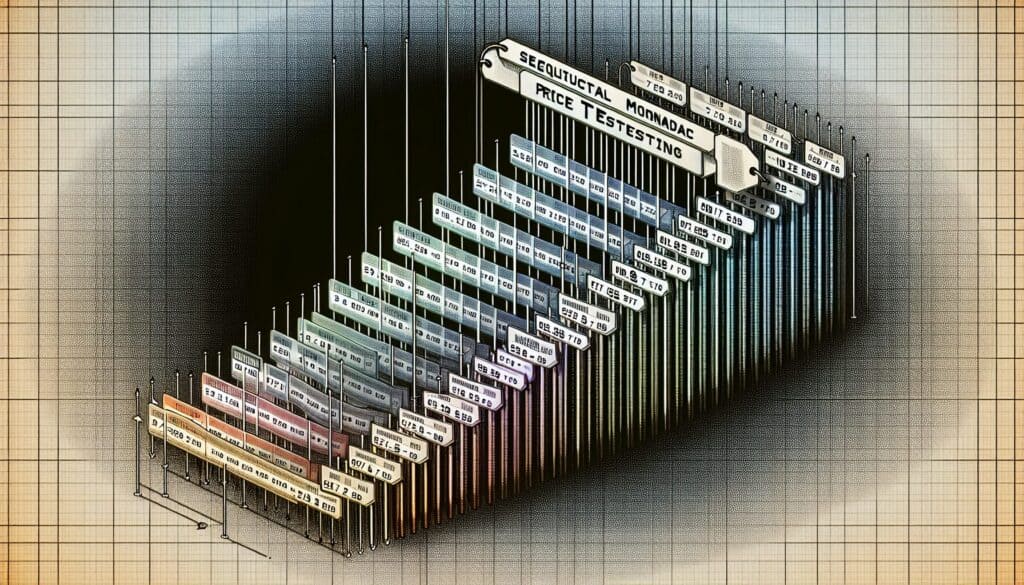Per valutare l'intenzione di acquisto di un prodotto su una gamma di punti di prezzo diversi presentati in sequenza allo stesso intervistato.
- Metodologie: Clienti e marketing, Economia, Progettazione del prodotto
Test dei prezzi monadici sequenziali (Price Laddering)

Test dei prezzi monadici sequenziali (Price Laddering)
- Metodologia agile, Esperienza del consumatore, Ricerca di mercato, Sviluppo del prodotto, Prezzi dei prodotti, Analisi statistica, Test dell'utente, Proposta di valore
Obiettivo:
Come si usa:
- Ogni intervistato viene esposto al prodotto e gli viene chiesto quale sia la sua probabilità di acquisto a una serie di prezzi, tipicamente presentati uno dopo l'altro (ad esempio, in ordine crescente o decrescente).
Professionisti
- Più efficiente dei test monadici puri, in quanto ogni intervistato valuta più prezzi, aiuta a capire la sensibilità ai prezzi su uno spettro.
Contro
- La distorsione dell'ordine può influenzare le risposte (ad esempio, il primo prezzo mostrato può influenzare i giudizi successivi), può essere cognitivamente impegnativa per gli intervistati se vengono mostrati troppi prezzi.
Categorie:
- Clienti e marketing, Economia
Ideale per:
- Valutare la probabilità di acquisto su più punti di prezzo con lo stesso gruppo di intervistati per misurare la sensibilità al prezzo.
Sequential Monadic Price Testing, or Price Laddering, finds its applications primarily in the consumer goods and technology sectors, where companies seek to optimize pricing strategies based on consumer behavior. Typically utilized during the concept testing and product development phases, this methodology involves engaging marketing researchers or product managers who are equipped to interpret the data collected. The participants in this testing are usually a diverse group of target consumers chosen to represent various market segments, ensuring that the findings are reflective of broader purchasing behaviors. Key industries leveraging this approach include electronics, automotive, and fast-moving consumer goods, where price elasticity can significantly impact market positioning and profitability. The testing allows for adjustments in pricing strategies before launch, ensuring that the final price point aligns with both consumer expectations and business objectives. This methodology facilitates a deep understanding of how consumers perceive value in relation to price, revealing thresholds beyond which demand may drop or spike. Specifically, it can uncover psychological pricing points that resonate well with potential buyers, informing subsequent marketing strategies and enhancing revenue management. This multi-price exposure yields richer data on consumer preferences compared to traditional monadic methods, making it an efficient choice for organizations striving to remain competitive in rapidly changing markets.
Fasi chiave di questa metodologia
- Define the product and its unique features.
- Select an appropriate sample of respondents for testing.
- Establish a range of prices for the product.
- Present each price point sequentially to respondents.
- Ask respondents to indicate their purchase likelihood after each price point.
- Monitor and record any changes in likelihood as prices adjust.
- Analyze the data for trends in price sensitivity.
- Identify optimal price points based on purchase likelihood responses.
Suggerimenti per i professionisti
- Incorporate a balanced number of price points to avoid overwhelming respondents, allowing focused responses for each price.
- Utilize randomized presentation orders to mitigate any bias that may arise from the sequence of price evaluation.
- Analyze the purchase likelihood along with demographic segments to identify specific price sensitivities within different consumer groups.
Leggere e confrontare diverse metodologie, raccomandiamo il
> Ampio archivio di metodologie <
insieme ad altre 400 metodologie.
I vostri commenti su questa metodologia o ulteriori informazioni sono benvenuti su sezione commenti qui sotto ↓ , così come tutte le idee o i link relativi all'ingegneria.
Contesto storico
1960
1980
1983
1990
1995
2000
2010
1950
1980
1980
1986
1994
1995
2000
(se la data non è nota o non è rilevante, ad esempio "meccanica dei fluidi", viene fornita una stima approssimativa della sua notevole comparsa)














Post correlati
Questionari sul disagio muscoloscheletrico
Test multivariati (MVT)
Analisi di regressione multipla
Sistemi di cattura del movimento
Metodo MoSCoW
Test mediano dell'umore